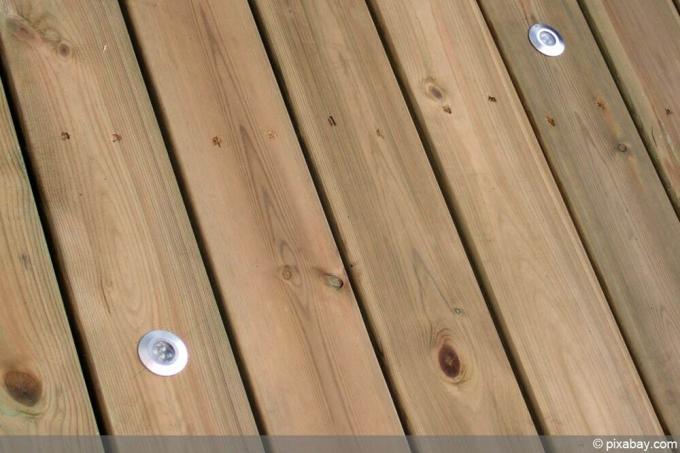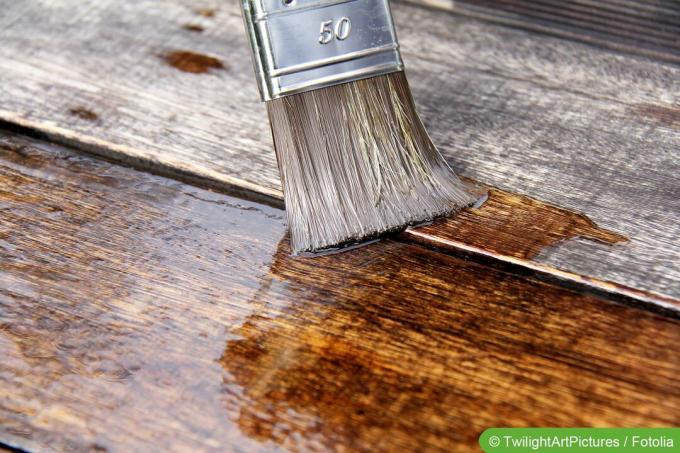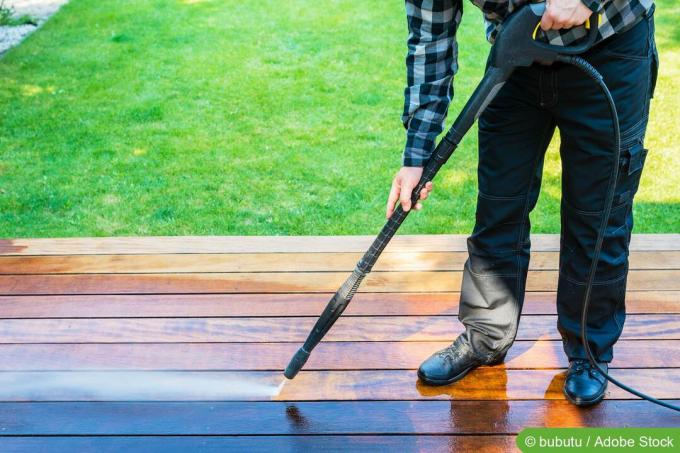

Table of contents
- cleaning
- Teak - Indoor
- Teak - Outdoor
- repair and maintenance
- Protection
- conservation and storage
Teak furniture and floors are expensive to buy and should therefore be properly cared for and cleaned so that the inherently robust material retains its beauty over time.
cleaning
Cleaning teak furniture or floors indoors or outdoors is comparatively easy if it has been given the appropriate protection. Various tools are available for removing dirt. Below:
- brush and water
- Kärcher or high-pressure cleaner
- rag
- soda
- curd soap
Teak - Indoor
Because the only thing that can soil teak furniture in the house or apartment is usually dust. Drinks and food can of course also land on it. Again, protected wood is easier to clean. If it has been oiled, glazed or painted, a simple (damp) wipe is often sufficient.
For light soiling on unprotected wood, we recommend preparing a solution of curd soap or washing soda and lukewarm water and brushing the surface with it. The high-pressure cleaner can be used for rinsing or to remove difficult dirt. If such a high-pressure cleaner is necessary, it should be used outdoors if possible.

Tip:
In any case, it is important that cleaning is carried out as early and regularly as possible. The sooner the dirt is removed, the less there is and the easier it is to remove.
Teak - Outdoor
Heavily used furniture that is heavily soiled needs to be treated a little differently. This is often garden furniture or a patio floor. Maintaining and cleaning teak means in these cases that the following procedure is recommended:
- Dry contaminants are removed by wiping and vacuuming. If they are stubborn, a dry sponge can also be used to loosen them.
- The protective layer of oil, varnish or glaze can be removed with a high-pressure cleaner if cracks or chipped areas are already visible. If this is not the case, the layer should be sanded down if necessary. For this purpose, a grinding device is used, which is first equipped with coarse and then with fine sandpaper. It makes sense to work dry at first and then wet - i.e. sanding first and then using a high-pressure cleaner if necessary. Indoors, this is far less necessary. However, it must always be ensured that an appropriate distance is maintained. The manufacturer provides relevant information on this.
- Once the protective layer has been removed, any unevenness can be smoothed out by grinding. Dirt and discoloration can be removed just like other residues. In addition, the wood is also upgraded in terms of appearance and function.
A notice:
Teak wood that has been thoroughly cleaned in this way should then be protected again in order to reduce the effort involved in subsequent cleaning and to extend its service life.
repair and maintenance
Before a suitable protective agent can be applied, it is not just a matter of thorough cleaning. It also applies to compensate for damage and other defects. Possible measures are:
gluing
Again and again it is falsely claimed that teak cannot be glued. In fact, due to the high oil content, some special features are required in the process. First, the adhesive surfaces must be roughened. A so-called two-component adhesive is then applied to the surfaces. Screw clamps can be used to ensure the connection between the two components and to create a resilient surface. The drying time is usually 24 hours. It is always safer to follow the manufacturer's instructions.
Colors
If there are errors or blemishes, color can be used to help. Pigmented lacquers and glazes or oils are ideal for achieving color matching. They also provide direct protection. Strictly speaking, they are not a repair, but can be used as a double layer when preparing for protection.

degreaser
So-called graying agents or special cleaners can freshen up the color of the teak and provide a significant improvement, especially with unprotected wood.
screws and nails
Nailing is not recommended due to the hardness of the wood. If two elements are to be connected to one another, a two-component or the use of screws should therefore be preferred. Due to the hardness, screwing is best done with special attachments and pre-drilled holes. Otherwise, not only is the effort significantly higher, but there can also be an increased risk of injury and material damage.
Protection
The application of protection can begin when the following points are met:
- the teak is cleaned
- Damage is not present or repaired
- the material is completely dry and absorbable
You can choose between oil, varnish and glaze for protection. Oil, glaze and clear coat preserve the grain. Colored lacquer can result in a single-colour surface. Colored glaze allows the grain to show through, but changes the tone of the wood. Oil gives the teak a soft shine. All agents can be applied with a paint roller or brush.
The general rule:
- Lacquer for heavy use
- Glaze for less stressed surfaces indoors and outdoors
- If possible, only use oil for teak wood indoors
Tip:
The wood can be glazed to change color and then varnished to seal. In any case, the individual drying time of the respective agent must be taken into account.
conservation and storage

Teak is extremely durable and not least because of this it is particularly popular. Nevertheless, it makes sense to take care of it and store it appropriately. Because the tropical wood can rarely be obtained sustainably. It is all the more important to handle it with care.
The following tips can help with this:
- store frost-free, dry and clean
- carry out regular and timely cleaning
- Renew protection quickly if necessary
- Immediately compensate for damage, for example to prevent further cracks
- use covers
Furniture used outdoors should be stored dry and clean, especially in winter. This prevents easily avoidable damage caused by moisture and sub-zero temperatures. If the furniture is used indoors, coasters and place mats help prevent stains.
 Home editorial office
Home editorial office
Learn more about decking wood

Which decking wood is the best? Comparison of wood types
When laying out a patio, there are many considerations to be made. After all, the floor and railing should last for many years, remain attractive and be able to withstand heavy loads. We reveal what is important in the selection and which decking wood is the best.

Douglas fir wood for the terrace - prices, durability and care
The Douglas fir is one of the native types of wood and has a nice, warm and somewhat reddish hue that is similar to larch wood. It is quite weather resistant and can therefore also be used for garden furniture and patio floors.

Exclusive natural pool: how much does a swimming pond cost?
Swimming ponds are becoming increasingly popular with many homeowners as an alternative to the classic swimming pool. An exclusive natural pool combines the properties of a swimming pond with the amenities of a pool. The customization options for an exclusive swimming pond depend on individual taste.

Wooden terrace - which wood, which glaze to use
If you want to enjoy your wooden terrace for a long time, choosing the right wood and caring for it is essential.

Cleaning a wooden terrace – which wood is easy to care for?
Once again, cleaning the decking is on the to-do list. Oak, Douglas fir, teak, larch or Bangkirai - different types of wood require different care and cleaning methods.

Wooden terrace - which popular types of wood to choose?
For many, the terrace offers additional living space in the warm season, which people like to use for a cozy get-together. If you are considering covering the floor with a wooden covering, you will find a difficult to oversee range of garden wood and corresponding kits in the DIY and specialist stores.
